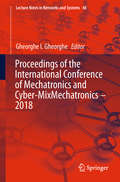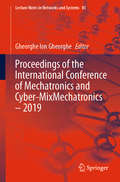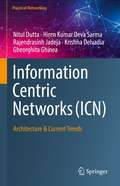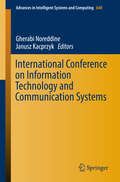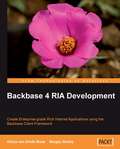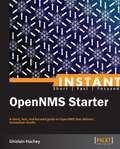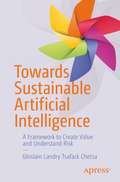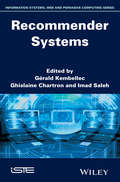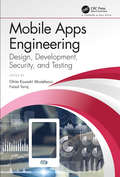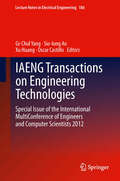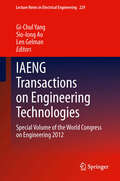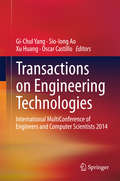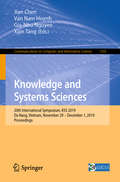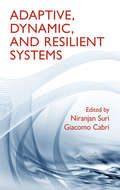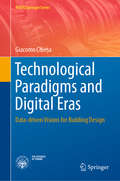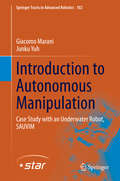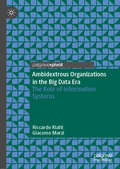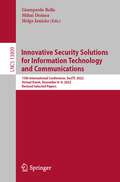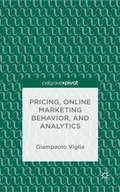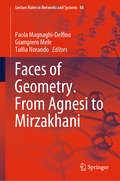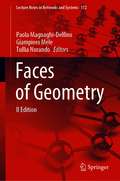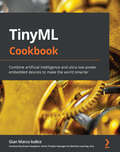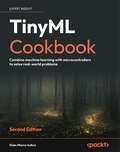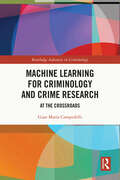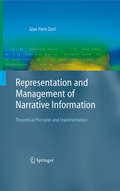- Table View
- List View
Proceedings of the International Conference of Mechatronics and Cyber-MixMechatronics – 2018 (Lecture Notes in Networks and Systems #48)
by Gheorghe I. GheorgheThis proceedings book gathers contributions presented at the 2nd International Conference of Mechatronics and Cyber-MixMechatronics/ICOMECYME, organized by the National Institute of R&D in Mechatronics and Measurement Technique in Bucharest, Romania, on September 6th–7th, 2018. Further, it reflect the expansion of the field of Mechatronics, which has yielded newer trans-disciplinary fields including Adaptronics, Integronics, and Cyber-Mix-Mechatronics. These are also the topics addressed by the respective book chapters. The conference has a rich scientific tradition and attracts specialists from all over the world – including North America, South America, and Asia. ICOMECYME is focused on presenting research results and is mainly directed at academics and advanced students, but also offers a venue for interacting with R&D experts. These proceedings will especially benefit entrepreneurs who want to invest in research and who are open for collaborations.
Proceedings of the International Conference of Mechatronics and Cyber-MixMechatronics – 2019 (Lecture Notes in Networks and Systems #85)
by Gheorghe Ion GheorgheThese proceedings gather contributions presented at the 3rd International Conference of Mechatronics and Cyber-MixMechatronics/ICOMECYME, organized by the National Institute of R&D in Mechatronics and Measurement Technique in Bucharest, Romania, on September 5th–6th, 2019. Reflecting the expansion mechatronics, it discusses topics in the newer trans-disciplinary fields, such as adaptronics, integronics, and cyber-mixmechatronics. With a rich scientific tradition and attracting specialists from around the globe – including North America, South America, and Asia – ICOMECYME focuses on presenting the latest research. It is mainly directed at academics and advanced students, but also appeals to R&D experts, offering a platform for scientific exchange. These proceedings are a valuable resource for entrepreneurs who want to invest in research and who are open for collaborations.
Information Centric Networks: Architecture & Current Trends (Practical Networking)
by Hiren Kumar Sarma Nitul Dutta Rajendrasinh Jadeja Krishna Delvadia Gheorghita GhineaThis book aimed at bringing an insight to the ICN network, particularly various architectures, issues and challenges in the new networking paradigm. The book starts with an introduction to the new promising concept of ICN and its origin along with the reason behind this interesting innovation. Different architectures proposed so far in support of implementing the ICN is also discussed in details. Few of the challenges of ICN implementation are enlisted as caching, naming, routing, and security. Each of these challenges with recent development is covered in individual chapters. Moreover, integration of current trends in communication and computing like software defined networking and machine learning approach are another area that this book is focusing. All these chapters highlight the recent developments reported in the area and also discusses the future trends. The book provides an overview of the recent developments in future internet technologies, bringing together the advancements that have been made in ICN. The book includes three unique chapters in the field of ICN research. The first, is the SDN framework for implementing ICN by decoupling data and control plan. The machine learning models for predicting future trends in network traffic and other management activities is another important chapter. This chapter includes the possibilities of using machine learning models for trend prediction to help network administrators and service providers to take care of unexpected sudden change traffic pattern and user behaviour. The third most vital chapter is the security issues in ICN. This chapter includes various facts that influences the security of ICN. Issues involved in naming, caching and routing are discussed separately along with few recent works in these areas. Various types of attacks in ICN are also part of the discussion. The stated book would be useful for researchers in this area and will work as a reference for future work. Moreover, the content of the book would also be suitable as a supporting material for undergraduate and graduate level courses in computer science and electrical engineering.
International Conference on Information Technology and Communication Systems
by Janusz Kacprzyk Gherabi NoreddineThis book reports on advanced methods and theories in two related fields of research, Information Technology and Communication Systems. It provides professors, scientists, PhD students and engineers with a readily available guide to various approaches in Engineering Science. The book is divided into two major sections, the first of which covers Information Technology topics, including E-Learning, E-Government (egov), Data Mining, Text Mining, Ontologies, Semantic Similarity Databases, Multimedia Information Processing, and Applications. The second section addresses Communication Systems topics, including: Systems, Wireless and Network Computing, Software Security and Monitoring, Modern Antennas, and Smart Grids. The book gathers contributions presented at the International Conference on Information Technology and Communication Systems (ITCS 2017) held at the National School of Applied Sciences of Khouribga, Hassan 1st University, Morocco on March 28-29, 2017. This event was organized with the objective of bringing together researchers, developers, and practitioners from academia and industry working in all areas of Information Technology and Communication Systems. It not only highlights new methods, but also promotes collaborations between different communities working on related topics.
Backbase 4 RIA Development
by Ghica van Emde Boas Sergey IlinskyThis is a practical book, where every example is tested and all source code is available with the book. Each chapter ends with work on a sample application using the new things learned. At the end of the book there is a complete, usable Travel Blog application. This book is for web developers who want to develop applications using the Backbase Client Framework. It may also be interesting for web developers and web application architects who want to know more about XML-based web application architectures.
Instant OpenNMS Starter
by Ghislain HacheyGet to grips with a new technology, understand what it is and what it can do for you, and then get to work with the most important features and tasks. A starters' guide to learning OpenNMS with ease, with a focus on immediate results.Instant OpenNMS Starter is for network administrators of any level with a slight focus on the novice that would enjoy a swift glance at what OpenNMS has to offer. It assumes the reader will have knowledge of basic network operations and protocols such as the Internet Protocol Suite.
Towards Sustainable Artificial Intelligence: A Framework to Create Value and Understand Risk
by Ghislain Landry Tsafack ChetsaSo far, little effort has been devoted to developing practical approaches on how to develop and deploy AI systems that meet certain standards and principles. This is despite the importance of principles such as privacy, fairness, and social equality taking centre stage in discussions around AI. However, for an organization, failing to meet those standards can give rise to significant lost opportunities. It may further lead to an organization’s demise, as the example of Cambridge Analytica demonstrates. It is, however, possible to pursue a practical approach for the design, development, and deployment of sustainable AI systems that incorporates both business and human values and principles. This book discusses the concept of sustainability in the context of artificial intelligence. In order to help businesses achieve this objective, the author introduces the sustainable artificial intelligence framework (SAIF), designed as a reference guide in the development and deployment of AI systems. The SAIF developed in the book is designed to help decision makers such as policy makers, boards, C-suites, managers, and data scientists create AI systems that meet ethical principles. By focusing on four pillars related to the socio-economic and political impact of AI, the SAIF creates an environment through which an organization learns to understand its risk and exposure to any undesired consequences of AI, and the impact of AI on its ability to create value in the short, medium, and long term. What You Will Learn See the relevance of ethics to the practice of data science and AI Examine the elements that enable AI within an organization Discover the challenges of developing AI systems that meet certain human or specific standards Explore the challenges of AI governance Absorb the key factors to consider when evaluating AI systems Who This Book Is For Decision makers such as government officials, members of the C-suite and other business managers, and data scientists as well as any technology expert aspiring to a data-related leadership role.
Recommender Systems
by Gérald Kembellec Ghislaine Chartron Imad SalehAcclaimed by various content platforms (books, music, movies) and auction sites online, recommendation systems are key elements of digital strategies. If development was originally intended for the performance of information systems, the issues are now massively moved on logical optimization of the customer relationship, with the main objective to maximize potential sales. On the transdisciplinary approach, engines and recommender systems brings together contributions linking information science and communications, marketing, sociology, mathematics and computing. It deals with the understanding of the underlying models for recommender systems and describes their historical perspective. It also analyzes their development in the content offerings and assesses their impact on user behavior.
Mobile Apps Engineering: Design, Development, Security, and Testing
by Ghita Kouadri Mostefaoui and Faisal TariqThe objective of this edited book is to gather best practices in the development and management of mobile apps projects. Mobile Apps Engineering aims to provide software engineering lecturers, students and researchers of mobile computing a starting point for developing successful mobile apps. To achieve these objectives, the book’s contributors emphasize the essential concepts of the field, such as apps design, testing and security, with the intention of offering a compact, self-contained book which shall stimulate further research interest in the topic. The editors hope and believe that their efforts in bringing this book together can make mobile apps engineering an independent discipline inspired by traditional software engineering, but taking into account the new challenges posed by mobile computing.
IAENG Transactions on Engineering Technologies
by Sio-Iong Ao Oscar Castillo Gi-Chul Yang Xu HuangThis volume contains revised and extended research articles written by prominent researchers participating in the conference. Topics covered include engineering physics, communications systems, control theory, automation, engineering mathematics, scientific computing, industrial engineering, and industrial applications. IAENG Transactions on Engineering Technologies: Special Issue of the International MultiConference of Engineers and Computer Scientists 2012 offers the state of art of tremendous advances in engineering technologies and physical science and applications, and also serves as an excellent reference work for researchers and graduate students working with/on engineering technologies and physical science and applications.
IAENG Transactions on Engineering Technologies
by Len Gelman Gi-Chul Yang Sio-Long AoThis book contains fifty-eight revised and extended research articles written by prominent researchers participating in the Advances in Engineering Technologies and Physical Science conference, held in London, U.K., 4-6 July, 2012. Topics covered include Applied and Engineering Mathematics, Computational Statistics, Mechanical Engineering, Bioengineering, Internet Engineering, Wireless Networks, Knowledge Engineering, Computational Intelligence, High Performance Computing, Manufacturing Engineering, and industrial applications. The book offers the state of art of tremendous advances in engineering technologies and physical science and applications, and also serves as an excellent reference work for researchers and graduate students working on engineering technologies and physical science and applications.
Transactions on Engineering Technologies
by Sio-Iong Ao Oscar Castillo Gi-Chul Yang Xu HuangThis volume comprises selected extended papers written by prominent researchers participating in the International MultiConference of Engineers and Computer Scientists 2015, Hong Kong, 18-20 March 2015. The conference served as a platform for discussion of frontier topics in theoretical and applied engineering and computer science, and subjects covered include communications systems, control theory and automation, bioinformatics, artificial intelligence, data mining, engineering mathematics, scientific computing, engineering physics, electrical engineering, and industrial applications. The book describes the state-of-the-art in engineering technologies and computer science and its applications, and will serve as an excellent reference for industrial and academic researchers and graduate students working in these fields.
Knowledge and Systems Sciences: 20th International Symposium, KSS 2019, Da Nang, Vietnam, November 29 – December 1, 2019, Proceedings (Communications in Computer and Information Science #1103)
by Jian Chen Xijin Tang Van Nam Huynh Gia-Nhu NguyenThis book constitutes the refereed proceedings of the 20th International Symposium on Knowledge and Systems Sciences, KSS 2019, held in Da Nang, Vietnam, in November 2019. The 14 revised full papers presented were carefully reviewed and selected from 31 submissions. This year KSS provides opportunities for presenting interesting new research results, facilitating interdisciplinary discussions, and leading to knowledge transfer under the theme of "Knowledge Science in the Age of Big Data".
Adaptive, Dynamic, and Resilient Systems
by Niranjan Suri Giacomo CabriAs the complexity of today's networked computer systems grows, they become increasingly difficult to understand, predict, and control. Addressing these challenges requires new approaches to building these systems. Adaptive, Dynamic, and Resilient Systems supplies readers with various perspectives of the critical infrastructure that systems of netwo
Technological Paradigms and Digital Eras: Data-driven Visions for Building Design (PoliTO Springer Series)
by Giacomo ChiesaThe book connects the ICT and the architectural worlds, analyzing modeling, materialization and data-driven visions for design issues at different scales. Furthermore, using sample modeling and materialization tools, it explores the links between performance-driven design approaches and the application of new digital technologies. Intended for architects and urbanists, it provides a theoretical framework to address the implications of the digital revolution in building design and operation. Furthermore, combining insights from IT and ICT with architectural and urban design know-how, it offers engineering professionals a technology-driven interpretation of the building design field.
Introduction to Autonomous Manipulation
by Giacomo Marani Junku Yuh"Autonomous manipulation" is a challenge in robotic technologies. It refers to the capability of a mobile robot system with one or more manipulators that performs intervention tasks requiring physical contacts in unstructured environments and without continuous human supervision. Achieving autonomous manipulation capability is a quantum leap in robotic technologies as it is currently beyond the state of the art in robotics. This book addresses issues with the complexity of the problems encountered in autonomous manipulation including representation and modeling of robotic structures, kinematic and dynamic robotic control, kinematic and algorithmic singularity avoidance, dynamic task priority, workspace optimization and environment perception. Further development in autonomous manipulation should be able to provide robust improvements of the solutions for all of the above issues. The book provides an extensive tract on sensory-based autonomous manipulation for intervention tasks in unstructured environments. After presenting the theoretical foundations for kinematic and dynamic modelling as well as task-priority based kinematic control of multi-body systems, the work is focused on one of the most advanced underwater vehicle-manipulator system, SAUVIM (Semi-Autonomous Underwater Vehicle for Intervention Missions). Solutions to the problem of target identification and localization are proposed, a number of significant case studies are discussed and practical examples an d experimental/simulation results are presented. The book may inspire the robot research community to further investigate critical issues in autonomous manipulation and to develop robot systems that can profoundly impact our society for the better.
Ambidextrous Organizations in the Big Data Era: The Role of Information Systems
by Riccardo Rialti Giacomo MarziAddressing the effect of big data analytics-capable information systems on organizational ambidexterity, this book investigates how these systems can be used to enhance organizational agility and flexibility, generally considered to be two key determinants of organizational ambidexterity. With a focus on the opportunities for businesses rather than the burden that big data can represent, the authors highlight the impact of big data on ambidextrous organizations and how current organizational structures can be modified in order to improve big data analytics and implement big data-capable information systems.
Innovative Security Solutions for Information Technology and Communications: 15th International Conference, SecITC 2022, Virtual Event, December 8–9, 2022, Revised Selected Papers (Lecture Notes in Computer Science #13809)
by Helge Janicke Mihai Doinea Giampaolo BellaThis book constitutes the refereed post-conference proceedings of the 15th International Conference on Innovative Security Solutions for Information Technology and Communications, SecITC 2022, held as a virtual event, during December 8–9, 2022. The 19 revised full papers presented together with 1 invited talk were carefully reviewed and selected from 53 submissions. The papers cover topics such as cryptographic algorithms, digital forensics and cyber security and much more.
Pricing, Online Marketing Behavior, and Analytics
by Giampaolo VigliaBehavioral Pricing, Online Marketing Behavior, and Analytics covers many different aspects of how online marketing works and its continuous evolution.
Faces of Geometry. From Agnesi to Mirzakhani (Lecture Notes in Networks and Systems #88)
by Paola Magnaghi-Delfino Giampiero Mele Tullia NorandoThe volume reports on interdisciplinary discussions and interactions between theoretical research and practical studies on geometric structures and their applications in architecture, the arts, design, education, engineering, and mathematics. These related fields of research can enrich each other and renew their mutual interest in these topics through networks of shared inspiration, and can ultimately enhance the quality of geometry and graphics education. Particular attention is dedicated to the contributions that women have made to the scientific community and especially mathematics. The book introduces engineers, architects and designers interested in computer applications, graphics and geometry to the latest advances in the field, with a particular focus on science, the arts and mathematics education.
Faces of Geometry: II Edition (Lecture Notes in Networks and Systems #172)
by Paola Magnaghi-Delfino Giampiero Mele Tullia NorandoThe volume reports on interdisciplinary discussions and interactions between theoretical research and practical studies on geometric structures and their applications in architecture, the arts, design, education, engineering, and mathematics. These related fields of research can enrich each other and renew their mutual interest in these topics through networks of shared inspiration, and can ultimately enhance the quality of geometry and graphics education. Particular attention is dedicated to the contributions that women have made to the scientific community and especially mathematics. The book introduces engineers, architects and designers interested in computer applications, graphics and geometry to the latest advances in the field, with a particular focus on science, the arts and mathematics education.
TinyML Cookbook: Combine artificial intelligence and ultra-low-power embedded devices to make the world smarter
by Gian Marco Iodice Ronan NaughtonWork through over 50 recipes to develop smart applications on Arduino Nano 33 BLE Sense and Raspberry Pi Pico using the power of machine learningKey FeaturesTrain and deploy ML models on Arduino Nano 33 BLE Sense and Raspberry Pi PicoWork with different ML frameworks such as TensorFlow Lite for Microcontrollers and Edge ImpulseExplore cutting-edge technologies such as microTVM and Arm Ethos-U55 microNPUBook DescriptionThis book explores TinyML, a fast-growing field at the unique intersection of machine learning and embedded systems to make AI ubiquitous with extremely low-powered devices such as microcontrollers. The TinyML Cookbook starts with a practical introduction to this multidisciplinary field to get you up to speed with some of the fundamentals for deploying intelligent applications on Arduino Nano 33 BLE Sense and Raspberry Pi Pico. As you progress, you'll tackle various problems that you may encounter while prototyping microcontrollers, such as controlling the LED state with GPIO and a push-button, supplying power to microcontrollers with batteries, and more. Next, you'll cover recipes relating to temperature, humidity, and the three “V” sensors (Voice, Vision, and Vibration) to gain the necessary skills to implement end-to-end smart applications in different scenarios. Later, you'll learn best practices for building tiny models for memory-constrained microcontrollers. Finally, you'll explore two of the most recent technologies, microTVM and microNPU that will help you step up your TinyML game. By the end of this book, you'll be well-versed with best practices and machine learning frameworks to develop ML apps easily on microcontrollers and have a clear understanding of the key aspects to consider during the development phase.What you will learnUnderstand the relevant microcontroller programming fundamentalsWork with real-world sensors such as the microphone, camera, and accelerometerRun on-device machine learning with TensorFlow Lite for MicrocontrollersImplement an app that responds to human voice with Edge ImpulseLeverage transfer learning to classify indoor rooms with Arduino Nano 33 BLE SenseCreate a gesture-recognition app with Raspberry Pi PicoDesign a CIFAR-10 model for memory-constrained microcontrollersRun an image classifier on a virtual Arm Ethos-U55 microNPU with microTVMWho this book is forThis book is for machine learning developers/engineers interested in developing machine learning applications on microcontrollers through practical examples quickly. Basic familiarity with C/C++, the Python programming language, and the command-line interface (CLI) is required. However, no prior knowledge of microcontrollers is necessary.
TinyML Cookbook: Combine machine learning with microcontrollers to solve real-world problems
by Gian Marco IodiceOver 70 recipes to help you develop smart applications on Arduino Nano 33 BLE Sense, Raspberry Pi Pico, and SparkFun RedBoard Artemis Nano using the power of machine learning Purchase of the print or Kindle book includes a free eBook in PDF format.Key FeaturesOver 20+ new recipes, including recognizing music genres and detecting objects in a sceneCreate practical examples using TensorFlow Lite for Microcontrollers, Edge Impulse, and moreExplore cutting-edge technologies, such as on-device training for updating models without data leaving the deviceBook DescriptionDiscover the incredible world of tiny Machine Learning (tinyML) and create smart projects using real-world data sensors with the Arduino Nano 33 BLE Sense, Raspberry Pi Pico, and SparkFun RedBoard Artemis Nano. TinyML Cookbook, Second Edition, will show you how to build unique end-to-end ML applications using temperature, humidity, vision, audio, and accelerometer sensors in different scenarios. These projects will equip you with the knowledge and skills to bring intelligence to microcontrollers. You'll train custom models from weather prediction to real-time speech recognition using TensorFlow and Edge Impulse.Expert tips will help you squeeze ML models into tight memory budgets and accelerate performance using CMSIS-DSP. This improved edition includes new recipes featuring an LSTM neural network to recognize music genres and the Faster-Objects-More-Objects (FOMO) algorithm for detecting objects in a scene. Furthermore, you’ll work on scikit-learn model deployment on microcontrollers, implement on-device training, and deploy a model using microTVM, including on a microNPU. This beginner-friendly and comprehensive book will help you stay up to date with the latest developments in the tinyML community and give you the knowledge to build unique projects with microcontrollers!What you will learnUnderstand the microcontroller programming fundamentalsWork with real-world sensors, such as the microphone, camera, and accelerometerImplement an app that responds to human voice or recognizes music genresLeverage transfer learning with FOMO and KerasLearn best practices on how to use the CMSIS-DSP libraryCreate a gesture-recognition app to build a remote controlDesign a CIFAR-10 model for memory-constrained microcontrollersTrain a neural network on microcontrollersWho this book is forThis book is ideal for machine learning engineers or data scientists looking to build embedded/edge ML applications and IoT developers who want to add machine learning capabilities to their devices. If you’re an engineer, student, or hobbyist interested in exploring tinyML, then this book is your perfect companion. Basic familiarity with C/C++ and Python programming is a prerequisite; however, no prior knowledge of microcontrollers is necessary to get started with this book.
Machine Learning for Criminology and Crime Research: At the Crossroads (Routledge Advances in Criminology)
by Gian Maria CampedelliMachine Learning for Criminology and Crime Research: At the Crossroads reviews the roots of the intersection between machine learning, artificial intelligence (AI), and research on crime; examines the current state of the art in this area of scholarly inquiry; and discusses future perspectives that may emerge from this relationship. As machine learning and AI approaches become increasingly pervasive, it is critical for criminology and crime research to reflect on the ways in which these paradigms could reshape the study of crime. In response, this book seeks to stimulate this discussion. The opening part is framed through a historical lens, with the first chapter dedicated to the origins of the relationship between AI and research on crime, refuting the "novelty narrative" that often surrounds this debate. The second presents a compact overview of the history of AI, further providing a nontechnical primer on machine learning. The following chapter reviews some of the most important trends in computational criminology and quantitatively characterizing publication patterns at the intersection of AI and criminology, through a network science approach. This book also looks to the future, proposing two goals and four pathways to increase the positive societal impact of algorithmic systems in research on crime. The sixth chapter provides a survey of the methods emerging from the integration of machine learning and causal inference, showcasing their promise for answering a range of critical questions. With its transdisciplinary approach, Machine Learning for Criminology and Crime Research is important reading for scholars and students in criminology, criminal justice, sociology, and economics, as well as AI, data sciences and statistics, and computer science.
Representation and Management of Narrative Information
by Gian Piero ZarriA big amount of important, 'economically relevant' information, is buried within the huge mass of multimedia documents that correspond to some form of 'narrative' description. Due to the ubiquity of these 'narrative' resources, being able to represent in a general, accurate, and effective way their semantic content - i.e., their key 'meaning' - is then both conceptually relevant and economically important. In this book, we present the main properties of NKRL ('Narrative Knowledge Representation Language'), a language expressly designed for representing, in a standardised way, the 'meaning' of complex multimedia narrative documents. NKRL is a fully implemented language/environment. The software exists in two versions, an ORACLE-supported version and a file-oriented one. Written from a multidisciplinary perspective, this exhaustive description of NKRL and of the associated knowledge representation principles will be an invaluable source of reference for practitioners, researchers, and graduates.
